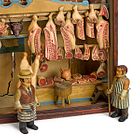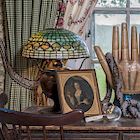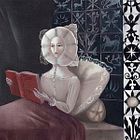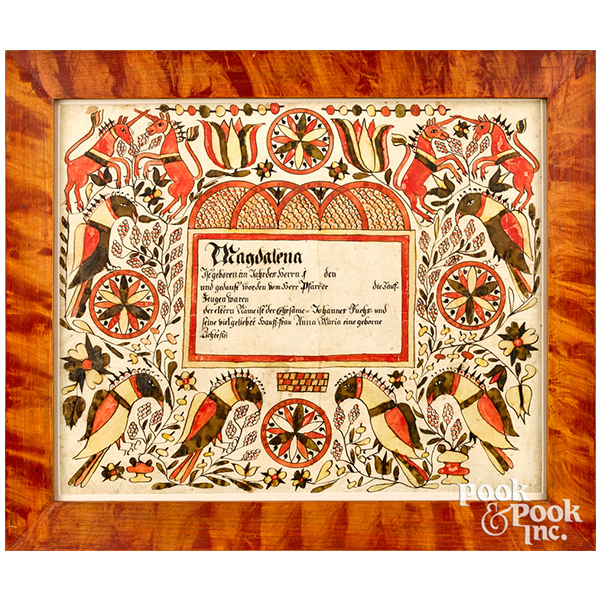The Collection of Drs. Donald & Patricia Herr, Pook & Pook, Inc. Auctioneers and Appraisers
- Folk Art
- Pook & Pook
- Pook & Pook, Inc
- Pennsylvania German
- American Art
- American Folk Art Paintings
- American furniture
- American Pewter
- Americana
Collectors of Pennsylvania German folk art for six decades, Donald and Patricia Herr became true connoisseurs, retaining only the best examples of an artist’s work, the best of a form, and the rarest and most highly sought after examples. Researching and documenting their collection, Drs. Donald and Patricia Herr may have applied scientific method to antiques.
Lot 201 Christian Beschler fraktur. Drs. Don Herr and Don Yoder collaborated to uncover the identity of the “Sussel Unicorn Artist.”
They published studies and research papers on a wide range of Pennsylvania German subjects. They recorded their observations, made comparative studies, and researched provenance and the progress of objects, artisans, and families through time. The Herrs uncovered relationships and made connections, adding greatly to the study of Pennsylvania German artists and craftspeople. Throughout the collection, common family names crop up on diverse items. Alongside the colorful painted wooden creations of Joseph Lehn, one finds his copybook, dated 1843, and a fraktur by his son Henrich Lehn for his grandson, Joseph, born 1829. The Herr name is found on diverse objects, with a Herr family coverlet, a Grandmother Herr quilt, an 1828 David Herr watercolor fraktur of birds, and Herr family birth and baptismal frakturs. The Herr’s research led to new discoveries, such as when Dr. Herr and Dr. Don Yoder collaborated to uncover the identity of the “Sussel Unicorn Artist.” Schoolmaster Christian Beschler (Germany, Northumberland County, ca. 1800) created only ten known works, eight of which are taufscheine. Two of these rarities are a birth and baptismal certificate for Jacob Jaekle, dated 1796; and one for Magdalena Fuchs b. 1801. Both are profusely decorated with compass stars, hearts, unicorns, and parrots amid tulips, flowers, and vines. Other works in this stellar group include a Johann Heinrich Otto (Southeastern Pennsylvania active 1762-1797) watercolor fraktur of a parrot and bird perched on stylized flowers, and works by Georg Frederich Speyer, Henrich Dulheuer, Samuel Bentz, John Zinck, Jacob Andreas, and Christian Strenge.
Lot 435 Auctioneer Jamie Shearer: “Where do you find an almost three-hundred-year-old needlework in vibrant colors, still in its original frame? The skill level needed to create this remarkable work of art is very inspiring. I can envision a young girl spending hours with great care and thought expressing herself through needle and thread. Just as skilled as the best painter on canvas or the furniture maker with a chisel, an everlasting gift to the antique collectors in all of us.”
Patricia Herr’s collection documents early schools of needlework. Three works from the Marsh School (Philadelphia 1723-1795) include one by Ann Marsh herself, ca. 1730, a vibrant work with an urn of flowers with insect and bird, resting on a rolling lawn with sheep and a running dog, retaining the original tombstone arched walnut frame. Ann, alongside her mother Elizabeth, taught the daughters of elite Philadelphia Quaker families the art of ornamental embroidery. Marsh works are rare, and according to Betty Ring, are the earliest identifiable group of Philadelphia needleworks. Seven works from the Lititz Moravian School include a silk on silk memorial embroidered sampler, attributed to Mary Ann or Rebecca Catherine Peterson, ca. 1833, in memory of their father. In the words of Patricia Herr, it is “an outstanding example of the needlework done at the Lititz Moravian Boarding School. The silk needlework is 3 dimensional, the flowers & leaves standing out over the finely drawn girls on each side of tomb,”(theherrsantiques.com). Another highlight is the earliest known Lititz silk mourning embroidery, ca. 1805, attributed to Sara Pim, Columbia Mourns for Washington. From the school of Mrs. Catharine Welshans Buchanan, a scarce Marietta, Lancaster County silk on linen memorial needlework dated 1827 is inscribed Eliz Groshs work made in Marietta in Mrs. Buchnans School in the year of our Lord 1811. Attributed to Mary Zeller’s School, a silk on linen needlework inscribed Abigal Jones her work 1793, is the family record of Samuel and Elizabeth Jones and their eight children, with Adam and Eve depicted above a Georgian vision of Eden. A very rare Lampeter School silk on linen sampler, dated 1799, wrought by Phebe Harvey of Pennsbury Township, Chester County, is possibly the only known sampler naming the school. An important Colerain Township School, Lancaster County silk on linen sampler is rich in detail, with a floral border over two houses with green lawns, white picket fences, birds, and sheep. Dresden work became peculiar to Philadelphia in the mid to late 18th c. One of two featured works is a Philadelphia, Pennsylvania Dresden work sampler, dated 1787, wrought by Susanna Meyer, an excellent example of this form, with decorative ribbon border and original Philadelphia frame. A category highlight is an important Chester County, Pennsylvania needlework grouping of sewing articles. Made by Hannah Darlington, ca. 1785, each piece bears the maker’s name or initials.
Lot 56 Debra Pook:“This is a wonderful example of Chester County needlework. These very early sewing articles are all made by the same hand, by Hannah Darlington, from the well-known Quaker Darlington family. She created the fabulous flame stitch wallet in wool in 1785, and rollup pin case in silk in 1787. The rollup pinball is remarkable for being crowned with a stitched sampler. They are beautifully and expertly done and have survived in fine condition.”
The most coveted makers of wooden boxes hold a special place in the collection. An important John Palm Boyer (1833-1901), Brickerville, Lancaster County, painted pine seed chest, ca. 1860, retaining its original faux grain decoration, the case with a fall front lid over fifteen drawers, with a lower row of seven small drawers resting on bootjack feet. This cabinet remains in a remarkable state of preservation and is among the finest known examples of Boyer's work. Of twenty-three Joseph Lehn-related pieces featured, one is a painted poplar seed chest with decoupage decorated crest and sides and a brick red ground. There are two 19th c. Lancaster Weber dresser boxes, one red ground and one blue, each with vibrant floral decoration, houses and trees. Two early 19th c. Lancaster County Compass Artist works are featured. One of very few known examples is a painted poplar slide lid box decorated with red and white pinwheel flowers on a dark blue ground. Another, of more traditional form, is a painted poplar dome lid box intricately and profusely decorated with compass and freehand flowers. An important John Drissel (Lower Milford Township, Bucks County, late 18th/early 19th c.) painted pine slide lid box, the lid inscribed Johannes Stauffer Anno 1797 John Drissel his hand, is decorated with tulips and white wavy lines on a brick red ground.
Lot 67 Ronald Pook: “A great decorative item, this seed chest exemplifies the Pennsylvania German love of color and decoration. The drawers are too small to hold enough seed for a farm, so it was probably used to hold garden seed or small household items. It is in great condition.”
Highly desirable Pennsylvania German carvings include a Wilhelm Schimmel spread-winged eagle, with original polychrome surface and unusual gilt body, which sits alongside two spirited Peter Brubaker (Lancaster County, 1816-1898) carved and painted horses, one chestnut and one dapple grey. Engaging carved figural groups by George G. Wolfskill (Fivepointville, Lancaster County 1872-1940) include an entire foxhunt. Works by John Reber (Lehigh County, 1857-1938) rarely come on the market, yet here are five of them, including his most ambitious work, an important carved and painted figure of the celebrated Standardbred pacer Dan Patch. Reber captured the majesty of Dan Patch, undefeated holder of the world record for the mile, with a mien of justifiable arrogance. His competition was so hopelessly outclassed that it stopped racing against him altogether.
Metal works by artisans John Long (Sporting Hill, Rapho Township, Lancaster, 1787-1856) and Peter Derr (Tulpenhocken Township, Berks County, 1793-1868) exhibit the best qualities of their type. A rare John Long wrought iron and brass fat lamp, is inscribed Fanny M. Erisman Manufactured By John Long. John Long’s Betty lamps “are considered by many to be among the finest examples of Pennsylvania German smithwork… They exemplify the creativity and the love of form, function and design by the Pennsylvania Germans.” (Donald Herr, AAW, 2006) A Peter Derr iron, brass, and copper fat lamp is impressed P.D 1860, and is one of three Peter Derr works to be offered. A Willoughby Shade (Montgomery County, Pennsylvania, mid-19th c.) punched tin coffee pot is profusely decorated, not only with birds and flowers- a parade of elephants march around its flared base. An exceedingly rare item, a York, Pennsylvania copper saucepan and lid marked by John Lay is possibly the only example known.
Lot 462 Auctioneer James Pook: “This Johann Christoph Heyne Pennsylvania German ecclesiastical pewter flagon is the highlight of the sale. Only one other is privately owned.”
Pewter is the crown jewel in the Herr collection, abounding in rare and important items. A highly important Lancaster, Pennsylvania pewter flagon, ca. 1770, bears the touch of Johann Christoph Heyne (Germany, Lancaster 1715-1781). One of only two examples in private hands, it is “remarkable for its cultural assimilation of styles” (Herr, Pewter in Pennsylvania German Churches). Heyne came to America in 1742 as a member of the Moravians “First Sea Congregation.” Another work by Heyne, a ca. 1770 canteen, was a memorable find at a Carlisle flea market. The best American pewter exhibits simplicity, beauty, and innovation in the ways makers used their limited molds to create finely proportioned objects. One gifted pewterer stands above the rest. William Will (Germany, Philadelphia 1742-1798), patriot, statesman, and pewterer, was the son of John Will, who arrived in America in 1752. The Herrs collected the works of both father and son. Nine objects by William Will, include sugar bowls, mugs, a tulip tankard, a drum teapot, and the jewel of the collection, an important coffee pot, ca. 1780. While few examples of this form exist, it has remained one of the most iconic pieces of American pewter. Standing sixteen inches in height, its clean neoclassical lines and symmetry lend it visual impact. Of the works attributed to and bearing the touch of John Will (Germany, New York 1696-ca.1774), an important flagon and chalice, ca. 1760, has been traced to the Round Top Lutheran Church, Bethel, Duchess County, New York. Other highlights include a New York oval teapot, ca. 1745, bearing the touch Francs Bassett I, one of the rarest forms of American 18th c. design. Of the seven Philadelphia items in the collection bearing the Love touchmark, a standout is a highly rare Queen Anne teapot, late 18th c. Only a few Love teapots are known. Of five works by Parks Boyd (Philadelphia ca.1771-1819), a pewterer who worked at various places, including Elfreth’s Alley, is a quart tankard, ca. 1805, in a style found only in the Philadelphia area, its high dome and multiple fillets exhibiting a strong Scandinavian influence. Robert Palethorpe Jr. (Philadelphia 1797-1822) was Boyd’s neighbor, eventually purchasing his shop. The rare 3 ½ pint barrel mug, ca. 1820, is possibly the only known example by Palethorpe. Simon Edgell arrived in Philadelphia from England in 1713 or earlier, purchasing property on High (Market) Street. “Simon Edgell’s pewter is among the earliest and rarest of surviving American pewter,” with fewer than a dozen signed pieces known. (Herr, Pewter… p.131) A rare beaker, ca. 1730, bears his touch. It is likely the earliest marked American beaker and was purportedly used by the Bowmansville Mennonite Church.
A selection of rare and important objects, The Collection of Donald and Patricia Herr exemplifies their love of Pennsylvania German decorative arts. In the words of the Herr family, “These items represent heritage, craftsmanship, scholarship, and above all, cherished moments shared between Don and Trish and other collectors.” The auction will take place on June 9th & 10th, 2022. Online bidding is available via Bidsquare.
By Pook & Pook Inc
Copyright © 1999 - 2024 Pook & Pook Inc. All Rights Reserved.
- ON MAY 11, TURNER AUCTIONS + APPRAISALS IS DEVOTED TO ICONS: ONE MAN’S COLLECTION
- Rafael Osona's April 27 Daffodil Weekend Auction Artistry and Fine Craftsmanship
- A SECRET VAULT OPENS ON APRIL 21 AT TURNER AUCTIONS + APPRAISALS
- FINE ART: ONE MAN’S COLLECTION GOES UP FOR BID ON APRIL 6 AT TURNER AUCTIONS + APPRAISALS
- TIMING IS EVERYTHING: VINTAGE WATCHES GO UP FOR BID ON MARCH 24 AT TURNER AUCTIONS + APPRAISALS
- THE ESTATE OF EDWARD S. STEPHENSON FEATURES ARMS & ARMOR AND ASIAN DECORATIVE ARTS
- Discover Timeless Elegance at the 'Elegant Artistry: Rug and Art Auction'
- ANIMAL ART IS GETTING ALL THE LOVE IN PALM BEACH ON FEB 17th
- RETABLOS: THE ART OF DEVOTION GOES UP FOR BID ON FEBRUARY 24 AT TURNER AUCTIONS + APPRAISALS
- 100 Years | The Kindig Legacy
-
Sporting Immortality

-
Antique Toy Auction at Pook & Pook Inc, with Noel Barrett

-
The Collection of Mrs. John Gutfreund – Murray House, Villanova, Pennsylvania

-
Leonora Carrington Oil Painting Sells for More Than Twice the Asking Price in the Latin American Art Auction Hosted by Morton Subastas in Mexico City

-
Peter Tillou Collection Highlights Litchfield Auctions’ 25th Anniversary




 EUR
EUR CAD
CAD AUD
AUD GBP
GBP MXN
MXN HKD
HKD CNY
CNY MYR
MYR SEK
SEK SGD
SGD CHF
CHF THB
THB



.jpg)

